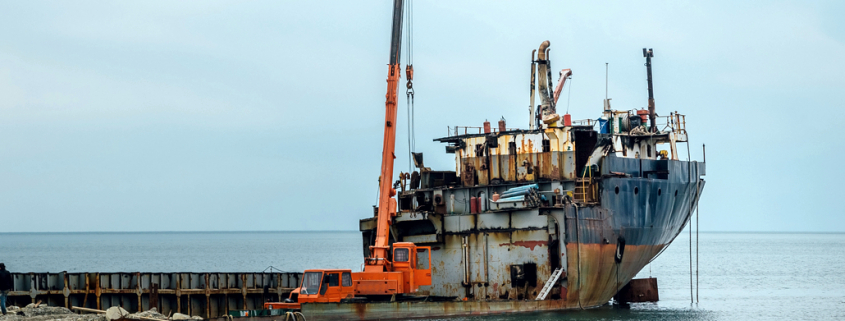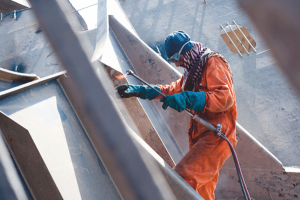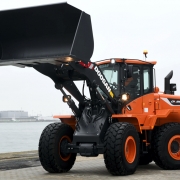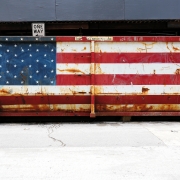How to Get a “Green” Ship Recycling
In 2018, in summary, 744 ships were dismantled worldwide, resulting in 18.9 million GT (Gross Tonnage) material.
With 253 wrecks, India scrapped a third of all ships by numbers, while Bangladesh, with nearly eight million GT, broke most material in terms of volume, indicating that this country’s yards were the preferred destination for larger vessels. In contrast, the EU scrapped 31 ships, delivered some 72,000 GT, and the local recycling yards dismantled mostly small-size vessels, according to NGO Shipbreaking Platform. If one follows figures of statistic-portal statista, most of the reported shipping tonnage sold for demolition in 2018 consisted of oil tankers, adding up to nearly 10.8 million GT, followed by bulk carriers with 2.5 million GT. The remaining vessels range from approximately 1.3 million GT (container ships) to 185,000 GT (ferries and passenger ships).
Five countries responsible for 97 percent
Although 82 countries are ship recycling domains, five of them are responsible for an average of 97 to 98 percent of all tonnage recycled globally, argued Nikos Mikelis, in 2013 non-executive director of GMS, the world’s leading cash buyer of ships for recycling. In his opinion, in 2013 each of “India, China, and Bangladesh have a large share of the world’s recycling capacity (i.e. between 24 percent and 31 percent), while Pakistan and Turkey have smaller but increasing shares of the world’s capacity (around 11 percent and four percent)”. For 2019, he reported a present capacity of 9.9 million GT in Bangladesh and 5.7 million GT in Pakistan, not to forget China with 8.2 million GT. In general, other countries could close up if their economy needs ferrous scrap imports and if the local labor costs can realize a steel scrap price under import price level. But Nikos Mikelis is sure that areas like the European Union, the USA or Canada could never be in a position to establish a major ship recycling industry: These economies do not need to import ferrous scrap and have to deal with high labor costs. “In such mature economies, it would appear that ship recycling can only exist as a service for disposing smaller or government-owned ships, or wrecks.”
EU list of recycling facilities
An opposite point of view, substituted by the NGO Shipbreaking Platform, says that in 2018, 518 from the 744 large ocean-going commercial vessels were sold to the scrapyards of Bangladesh, India and Pakistan and broken down on tidal mudflats, “amounting to a record-breaking 90.4 percent of the gross tonnage dismantled globally”. Instead of dangerous ship scrapping at Southeast Asian beaches, vessels, as a matter of principle, could have been treated at the 20 EU-listed yards that can handle the recycling demand of EU-flagged ships cleanly and safely. In January 2020, the list comprised 41 yards, including 34 facilities located in 12 EU Member States and Norway, six facilities in Turkey and one facility in the United States of America. Shortly before, Nikos Mikelis had warned that “it should be evident to all that EU SRR (European Regulation on Ship Recycling) will fail in its enforcement unless its List includes a not-insignificant number of South Asian yards.”
The European Union quickly widened its gathering ground: The list, updated in November 2020, comprised 40 recycling facilities located in countries that had applied for inclusion in the European List of ship recycling facilities – 20 in India, 14 in Turkey, four in China and two in the USA.
No chance of banning beaching
But there is by no means a chance that EU legislation or measures could stop unacceptable ship recycling practices in South Asia by banning beaching. The three leading countries Bangladesh, India and Pakistan – that already recycled more than two-thirds of the world’s recycled gross tonnage and even more of the world’s recycled lightweight in 2013 – would not put an end to their local practices on their grounds. In contrast, likely, European based end-of-life ships could immediately change their flag to get the best retailing options. Following Nikos Mikelis, the only winners would “prevail from the unclear, unenforceable and confusing regulatory requirements”, but certainly it would not change the working conditions of “the so-called exploited workers of South Asian ship recycling yards”.
EU recycling capacity developable
Another problem affects the recycling possibilities: Official data the International Maritime Organization resorts to indicate that the combined maximum annual recycling volume in the EU, including the United Kingdom and Norway, represents just 0.57 percent of the world’s capacity. And the overall tonnage the EU yards could recycle in 2018 totaled about 82,000 GT – correlating with 0.45 percent of the globally recycled volume. Figures of the European Maritime Safety Agency EMSA document suggest that the capacity needs to be doubled. It seems that there are also not enough adequate facilities to recycle the largest sea-going vessels. Therefore, Martin Dorsman, Secretary General of the European Community of Shipowners’ Associations ECSA underlined: “We were and still are worried that there is not enough capacity and certainly welcome the Commission’s current efforts to enlarge the list.” To retrieve to the existing facilities’ honor: EU yards are not only active in ship recycling but also focus on ship repair, conversion and off-shore works.
Re-rolled or melted steel scrap?
A third difficulty is associated with Europe as the world’s largest net exporter of scrap steel, the majority going to Turkey and some quantities also to India and China. Why should Europe recycle large end-of-life ships and transfer their material via ship to other countries? Or, in other words, and according to Nikos Mikelis: “It makes no sense to recycle large ships in Europe to produce scrap that will have to compete with the large quantities of other European ferrous scraps in order to be sold and transported to countries most of which already recycle ships.” Besides that, the South Asian steel industry prefers re-rolled ship’s scrap, as it is easier to process and up to 90 percent cheaper than melted steel scrap. There is no need to resort to expensive melted foreign material.
Conventions: Hong Kong versus Europe
The field of ship recycling rules is manageable but is divided – on the one hand – in nations attending the Statements of Compliance with the “Hong Kong Convention for the safe and environmentally sound recycling of ships” adopted in 2009 and since then waiting for prospective enforcement and – on the other hand – the EU region with an own Ship Recycling Regulation No 1257/2013: Based on the Basel Convention on the Control of Transboundary Movements of Hazardous Wastes and their Disposal, it entered into force on December 30, 2013. There are some gaps in the Hong Kong Convention, as it excludes several ship types, does not enforce the polluter pays principle, does not codify a solid recycling process and will not reduce beaching, for example. The drawbacks of the EU Regulation include – as a master thesis at the Free University of Brussels in 2019 stated – amongst others that not all ships worldwide fall under this regulation: ships can easily reflag from an EU flag to circumvent the regulation; the capacity for enforcement has to be enlarged; the cooperation between member states must be improved; it is unclear what role beaching facilities shall have. The European Institute for Asian Studies spoke of concerns that the Regulation might become a “paper tiger”, stimulating the debate, but very modest in changing the shipbreaking business in the yards of South Asia.
Two additive approaches
However, the European Regulation (related to Basel Convention) and Hong Kong Convention basically only differ in the way yards are authorized and in defining two additional hazardous materials to be controlled. A study on “Contributions of Ship Recycling in Bangladesh”, edited by the International Maritime Organization in 2017, underlined that “the EU Regulation is consistent with the Hong Kong Convention in many respects”. In other words, “the irony is that the Basel Convention and the Hong Kong Convention were never in conflict with one another in the first place … The two approaches are not duplicative but rather additive … But from a legal standpoint, there is no conflict, if the obligations are added and implemented at the same time”, expressed even a paper titled “Contradiction in terms: European Union must align its waste ship exports with international law and Green Deal”, edited by Greenpeace, Basel Action Network, European Environment Bureau and NGO Shipbreaking Platform in September 2020. Already in 2017, a study on ship recycling in Bangladesh underlined: “If EU wants to promote ‚responsible‘ ship recycling globally and minimize environmental footprints, it should develop a regulatory framework that does not shut down recycling industries in developing countries.” Additionally, it should give incentives to developing countries to improve their ship recycling practices and become ‘green’, “without depriving them from future economic prosperity”. The before mentioned thesis goes one step ahead and suggests that in the long term “more effort should be put into regulating the proper design of ships to facilitate safe and environmentally sound recycling”.
Potential to be a green business
Already in 2014, the European Institute for Asian Studies commemorated “that the aim is not to shut down this type of industry or to excessively burden developing countries, but to upgrade ship recycling to fulfill its ‚green business‘ potential, without depriving South Asia countries of economic opportunities”. And the institute argued that – “if conducted in an environmentally safe and sound manner” – ship recycling would have the potential to be a “green business” through re-use of materials, especially if newly designed ships have a cradle-to-grave approach in mind.
Compliance with all regulations
The Ship Recycling Transparency Initiative (SRTI) is sure to take a step in the right direction. As an “independent initiative” hosted by the Sustainable Shipping Initiative, it is supported by leaders from across the shipping value chain like – amongst others – the China Navigation Company, GES International, Hapag-Lloyd, Lloyd’s Register and A.P. Moeller-Maersk. In 2019, 41 percent of the signatories were shipowners, approximately 30 percent financial stakeholders and nearly 12 percent cargo owners like BMW and truck manufacturer Scania. The Initiative delivers a “vision of a world where ships are recycled responsibly – socially, environmentally and economically – going beyond international conventions and setting a new norm for responsible ship recycling”. And it wants to create “a new norm through the simple act of being transparent”. According to SRTI’s 2019 report, ship recycling policies adhere to a range of global and regional conventions, guidelines and principles, including first of all the Hong Kong Convention, the EU Ship Recycling Regulation, Basel Convention, United Nations Global Compact, OECD Guidelines of Multinational Enterprises, Stockholm POP Convention, and ISO Specifications 30000. The result: “All disclosing shipowners’ ship recycling policies cover the environment, labor and human rights; other issues commonly covered downstream facilities for managing waste and hazardous materials, health and safety as well as anti-corruption.”
Recycling more than 95 percent
The concept of Sea2Cradle, a global expert in green ship recycling, is different. The company “wants to meet the highest standards of health, safety and environment”, complying with all EU, International Marine Organization, Basel Convention and ILO legislation. Their portfolio reaches from making a ship recycling plan and finding a buyer to supervising the dismantling and recycling at the demolition yard. According to the slogan “zero pollution, zero incidents, zero accidents”, Sea2Cradle provides demolition yards with an accident-free working environment, proper disposal of hazardous materials without exposure to workers, and recycles more than 95 percent of all material aiming at 100 percent. Meanwhile, the enterprise looks back at 180 recycling projects.
Improvements have been made …
Undoubtedly, the practices of ship recycling have improved lately. According to the International Shipping News magazine, the last four years saw nearly 80 out of 120 ship recycling yards in India achieving Statements of Compliance with the Hong Kong Convention. The paper reports on ship recycling yard owners massively investing in upgrades of their recycling facilities by floors with drainage systems, heavy lift cranes, training for workers and implementation of Ship Recycling Facility Plans and Ship Recycling Plans following guidelines of the International Marine Organization. Yards incorporated in the International Ship Recycling Association (ISRA) made “huge investments” to achieve ISRA’s high-level demands for sustainable ship recycling. Now, the group claims to be “representing the strongest environmentally responsible yards in the world”. According to Hellenic Shipping News, in February 2020, many yards in India proclaimed an upgrade of their beaching facilities to comply with the Hong Kong Requirements. And in January 2020, the media gave account that the PHP Ship Breaking and Recycling Industries Limited, a ship recycling facility in Chattogram, was verified to be the first Bangladeshi recycling facility in line with the Hong Kong Convention.
… but it is not sufficient
This optimistic picture of an environment-friendly ship recycling future shows cracks when faced with the site inspection reports the EU Commission conducted in summer 2020 in the Indian coastal region Alang. Six facilities had applied for inclusion in the European List of ship recycling facilities. Since the first meeting, all of them “had made important investments in the last years to upgrade its infrastructure and ship recycling practices”, the reports confirm. But the proceedings set out a lack of adequate hospital facilities by limited emergency capabilities and underlined the fact that the place for treatment of serious injuries is located approximately 1.5 hours’ drive away from the Alang yards. All yards show difficulties in ensuring sustainable downstream management of wastes generated by the ship dismantling activities. Most of the generated waste is transferred to the local treatment storage and disposal facility. However, the operator is not able to handle certain types of wastes like e-waste, batteries or POPs. Therefore, these types of waste are transferred to other waste management facilities with yet unknown standards. At one yard the evaluators even criticized an incomplete Ship Recycling Facility Plan, the improvable environmental monitoring, missing measures for protecting the intertidal zone and a questionable drainage system for the secondary cutting zone. As the facility did not meet the requirements, it was suggested to evaluate improvements during a re-inspection of the facilities.
Investment in ship recycling seems to pay off. In 2016, India planned to invest 100 million rupees (1.5 million Euro) in improving ship recycling conditions at a recycling yard in Gujarat. Not for nothing, in October 2020, Norway showed interest in investing in the Bangladesh ship recycling industry. And in December 2020, China, banning the recycling of foreign ships on its shores at the end of 2018, was considering reversing its two-year-old decision.
But currently, the lockdown hit the branch hard in the first half of the year 2020: Mid-summer showed the selling of several Very Large Ore Carriers coupled with Capesize bulk carriers, and the last quarter was characterized by five hulking cruise ships being dismantled in Turkey, a mini price recovery for the ship recycling market and a “new optimism”, according to shipbroker Clarkson Platou Hellas. On the whole, the ship recycling sector is struggling economically. It remains up in the air when companies “are increasingly expected to make sure that their business, including their supply chain management, operate in line with international human rights standards and does not cause harm to the environment.”
(Published in GLOBAL RECYCLING Magazine 2/2021, Page 30, Photo: Mulderphoto/stock.adobe.com)











